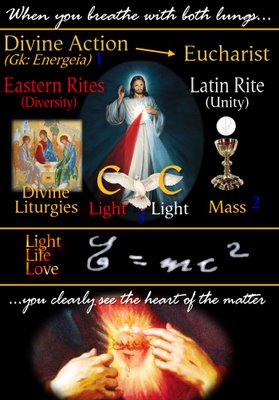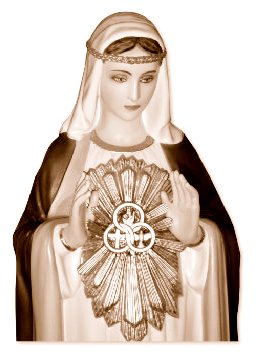Imago Trinitatis...a glimpse of Both/And Truth?
for Trinity Sunday, 2006 by Sr. Nora Coughlan SMG at
a report from an advocacy group to the United Nations.
In this report we find a disturbing mix---a hopeful dose of mystery
and the humanist agenda of the secular world that seeks to destroy
the heirarchy of the One, Holy, Catholic, Apostolic Church.
Authentic human development is not a matter of accumulating wealth, or power, or honors. It has nothing to do with the addiction to "more, more, more" beyond what is necessary to meet reasonable human needs. It has everything to do with becoming more human, and this means becoming what we are, living images of our Creator. In the Christian tradition, this is often expressed in terms of becoming imago Dei and, therefore, imago Trinitatis. The following image is the famous "Trinity Icon" by Andrei Rublev, circa 1420 CE. This picture is not worth a thousand words, or a million words; it is worth trillions of words.
Every detail in this icon has a profound theological and human development significance. Again, it would be presumptuous to think that we can become perfect images of God in this life. But we can and must improve the visibility of the image of God in each one of us. We can become more of what we already are. This is the most authentic kind of human development, even if it must happen in the midst of suffering and tribulations. And becoming more human is the most fruitful kind of human development, not only for personal growth but for the common good of humanity, let alone the glory of God.
The following points (and questions) are offered for meditation:
+ There are three Persons, from left to right: the Father, the Son, and the Holy Spirit. The bright blue is the color of the divinity. The dark red is the color of the humanity. The three angelic figures are divine Persons. The Son is divine (John 1:1) but assumed human nature (John 1:14). Question: do any of the three divine Persons is portrayed as being exclusively male? Is the masculinity of Jesus a divine attribute or a limitation of the human condition?
+ Both the Son and the Holy Spirit are turned toward the Father. This means that both the Son and the Holy Spirit proceed from the Father (Eastern Orthodox theology). The Father, who abides in unapproachable light (1 Timothy 6:16), is turned toward the Son and the Holy Spirit. Question: is there any attitude of tion shown by any of the divine Persons? What is the attitude of each Person toward the other two (1 John 4:8)?
+ Note the building in the background. In eastern iconography, this is indicative of deep interiority and communion among persons. But this is not an exclusivist interiority that is closed to those outside. The tree alludes to the hospitality given by Abraham to the three visitors at Mamre (Genesis 18:1-7). Question: is this an image of human solidarity resembling the trinitarian communion, or is this an image of violent rejection or aggressive self-protection?
+ The three divine persons are sharing a table and, on the table, there is a cup. The cup signifies the Eucharist, i.e., love bestowed. Question: have we reached the point in which homo sapiens becomes homo eucharisticus or, at least, homo solidarius? Can we go forward and become more human by giving up our current status as homo economicus, and become interested in something more than the triple patriarchal addiction?
+ Notice the hole in the base of the table. It seems to be a narrow entrance to a tunnel that leads to a sharing in the trinitarian communion. It seems that the tunnel is both narrow and straight. Question: could this be a symbol of the straight and narrow path that leads to life (Matthew 7:14)? Could this be a symbol of the narrow gate that leads to the abundant life (John 10:10)?
+ Take time to contemplate this icon in light of the creation accounts (Genesis 1 and 2). We know that each human being, male or female, is imago Dei. It follows that each human being, male or female, is imago Trinitatis. Question: can we say that homo economicus is a good imago Dei. If so, let's keep accumulating wealth, power, and honors. Else, how can we become, if not homo eucharisticus, at least homo solidarius?
+ Take another look at this beautiful icon, which the Russian Orthodox Church considers to be "proto-revealed." There is absolutely no sign of violence in this icon. The God of the Judeo-Christian tradition is a loving, nonviolent God. Question: isn't this the answer? Isn't it a matter of radically renouncing as a way to settle human issues? Isn't the fundamental obstacle that precludes our transition from a patriarchal mindset to a solidarity-sustainability ethos and sustainable human development?"
PONDER IT WELL, THIS ARTICLE IS PACKED WITH AN AGENDA
+++
+++
+++
+++
+++
+++
+++
+++
+++
+++
+++
+++
JESUS CHRIST IS LORD!
Imitate Mary
Seek the Light of Our Lord Jesus Christ!





























No comments:
Post a Comment